Come summer and it is a delightful celebration of raw mango, spices, and oil to make the iconic Avakaya in almost every Telugu-speaking home.
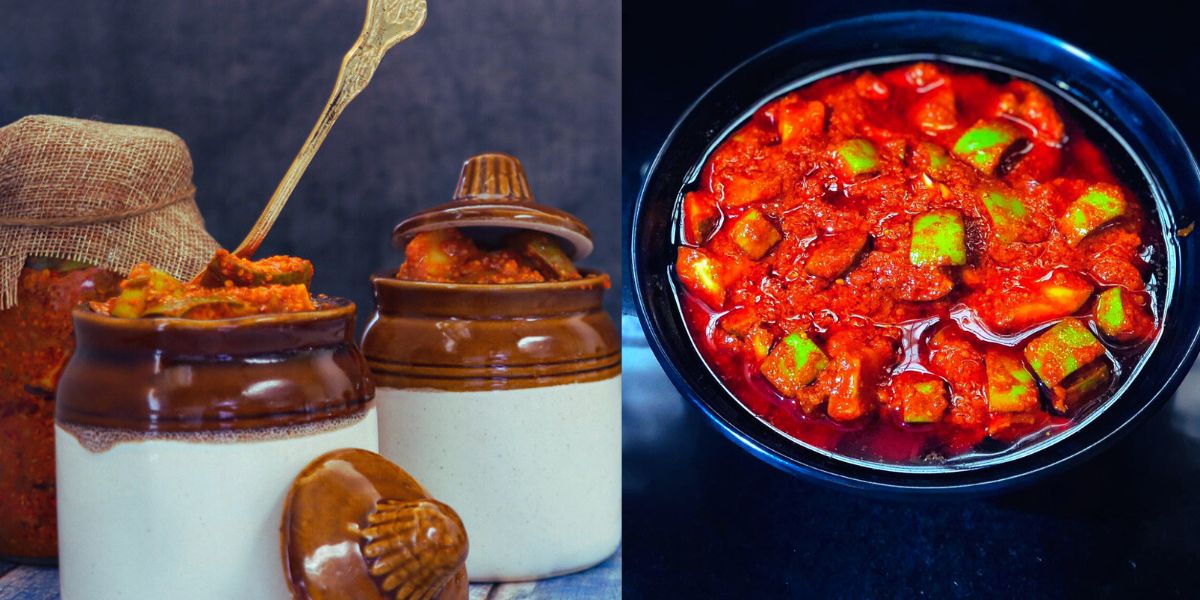
Avakaya pickle is an emotion for the Telugu-speaking population. (Supplied)
As a young hosteller, back in the day, the inevitable pangs of homesickness would strike when it was time to travel from Bhubaneswar to Delhi for a new term in college, even before the advent of the journey.
But travelling with me would be one comfort-providing companion, which would fulfil, with its delightfully tangy taste, both the much-needed supplementary sustenance and the craving for home-made familiar warmth, lacking in the indifferent hostel meals.
And that was the big bottle of mango avakaya made by my paternal aunt, who had mastered the art of pickling avakaya during my uncle’s stint in Hyderabad.
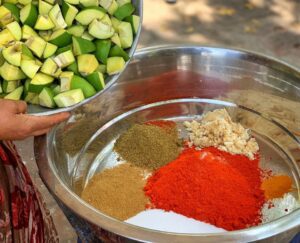
Avakaya-making requires perfect ingredients, attention to detail, and patience. (Ravi Kumar Thummula)
The sight of the brilliant orange-red shade of the pickle, paired with the delightful aromas of raw mango mingling with a delightful medley of mustard, garlic, red chilli powder, and gingelly oil, tantalised the taste buds even before one tasted the pickle.
It was serendipity, perhaps, a couple of decades later, when I got to witness the joie de vivre around the making of the avakaya. Every summer in Hyderabad, every household worth its Telugu family name gets into “pickling mode”.
Office colleagues would apply for leave for a couple of days during the month of April or May so that they could participate in the family ritual of making their stash of avakaya pickle for the season.
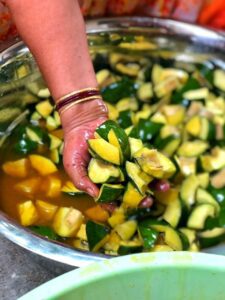
According to Ratna Rao, for Andhraiites, making avakaya is akin to the French making wine. (Ravi Kumar Thummula)
“For Andhraiites, making avakaya is akin to the French making wine, it is so intrinsic to our lives,” reminisces Ratna Rao, author and writer.
“I remember how every aspect of the avakaya-making had so much sanctity around it. From deciding the date (had to be made on one of the hottest summer days, so it would be around mid-May), sourcing ingredients from Monda Market in Secunderabad, to the mixing of spices, and keeping the wooden spoon to mix it moisture-free, as well as the fine muslin cloth used to secure the cover on top of the jars. We, children, would be strictly prohibited by my grandma to even touch the bottle of pickle or even the spoon used to mix it. Such was the aura around it, akin to following a religious ritual,” she adds.
The process left an indelible impression enough for Rao to dedicate almost an entire chapter to the process of making avakaya, complete with the description of chilli powder flying into her nostrils, in her book about growing up in Hyderabad, Footsteps in the Courtyard.
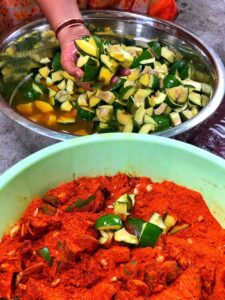
The sight of the brilliant orange-red shade of the pickle can tantalise the taste buds. (Ravi Kumar Thummula)
“It is nothing short of a celebration, for us Telugus,” states Chalapathi Rao, chef-partner at Hyderabad’s much-loved restaurant Simply South. He recalls the avakaya ritual at his grandparents’ ancestral home in East Godavari as a big part of his summer vacation.
“Early in the morning, I would see the family retainers, mostly male, chopping the raw mango into even-sized pieces. The cutting and chopping of raw mangoes is quite a task as the kernel is also used (before it becomes a full-fledged seed). So, this is mostly handled by the men folk, while the women of the house would then assemble the spices and gingelly oil, with my grandmother presiding over the proceedings,” he shares.
The mixing of spices with the mango would be then done by the women and the process would take about 3-4 days, after which the pickle would be ready to eat, reminisces the master chef who was part of the creative team behind Dakshin, ITC Hotels’ iconic South Indian brand.
“Keeping in mind my mother’s advancing years, I feel blessed to have received my share of avakaya pickle made by her even this year. Needless to say, at Simply South, we follow my home-grown recipe for avakaya pickles,” adds Chalapathi.
When it comes to the choice of mangoes and ingredients/spices used in making this tangy Andhra pickle, avakaya is a multi-layered genre. The prep techniques vary across households and regions, both within as well as between the two Telugu-speaking states of Andhra Pradesh and Telangana.
And while avakaya is considered predominantly an Andhra signature, foodpreneurs like Ravi Kumar Thummula, who hails from Nalgonda district of Telangana, reminisces the avakaya ritual from his years growing up. The process varies in details, which set them apart, such as the use of ginger-garlic paste and hot-oil tempering in the pickle in Telangana, as against the use of raw oil in Andhra.
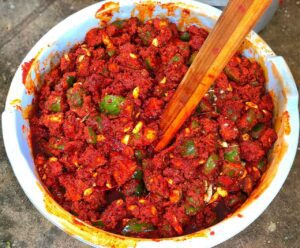
The red chilli powder is usually a proportion of 70:30 use of Guntur and Warangal chillies. (Ravi Kumar Thummula)
The variety of mangoes used depends on the customisation preferences of customers.
There are various types of avakaya: Bellam Avakaya (with jaggery), Bellulli Avakaya (with garlic), Dhaniyaala Avakaya (with coriander seeds), Nuvvu Avakaya (with sesame), Menthi kaaya (with fenugreek), Maagaaya (grated raw mango), Dosaavakaaya (with cucumber), Endi Avakaya (with dried mango pieces), and the list goes on!
“Chinna Rasaalu is mostly preferred, especially in the Krishna-Godavari districts of Andhra, for its pulpous fibre and while they are extremely sweet while ripened, Rasaalu is extremely sour when unripe,” says Thummula.
“Naatu Kayalu, Jalalu, and Totapuri are other options. The latter two are used for softer pieces of mango pickles and sweeter pickles, respectively. While gingelly or sesame oil is traditionally preferred for pickling avakaya, groundnut and sunflower oil are also commonly used options. The red chilli powder is usually a proportion of 70:30 use of Guntur and Warangal chillies, though I use only Guntur 341 chillies as they offer both colour and pungency,” elaborates Thummula.
Thummula, who makes about 6-7 tonnes of avakaya every season, uses freshly-ground spices, black mustard, jeera, methi, and the fiery red and pungent Guntur 341 chillies for its spicy quotient.
“Avakaya-making requires perfect ingredients, attention to detail, and patience. These days, homemakers and even commercial establishments use quick-fix methods to make the pickle. Brands are selling ready-to-use pickle powder and they use vinegar in pickles too to make them appear sour and for preservative purposes. But in our grandparents’ era, avakaya used to stay fresh for up to a year, thanks to the perfect techniques used of keeping moisture out, sunning the pickle, and storing them in properly cleaned and sun-dried ceramic jars. Of course, the quality of spices was also better,” adds Thummula.
Clearly, avakaya is an emotion for most of the Telugu-speaking population, be it from Andhra or Telangana, like Thummula.

May 03, 2024

May 02, 2024

May 02, 2024

May 02, 2024

May 02, 2024

May 02, 2024